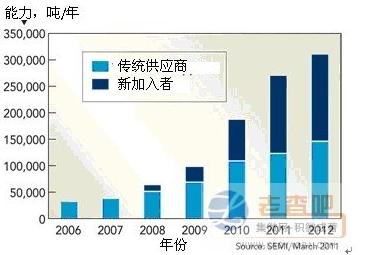 The global polysilicon capacity and predictions are due to the use of raw materials for the monocrystalline silicon wafer production process, for which polysilicon is the substrate, which is basically used to produce all semiconductors. Polysilicon is also a key component of silicon-based solar cells. In recent years, there has been explosive growth in photovoltaic production, and the availability of polysilicon has received widespread attention.
The global polysilicon capacity and predictions are due to the use of raw materials for the monocrystalline silicon wafer production process, for which polysilicon is the substrate, which is basically used to produce all semiconductors. Polysilicon is also a key component of silicon-based solar cells. In recent years, there has been explosive growth in photovoltaic production, and the availability of polysilicon has received widespread attention. Historically, the semiconductor industry has consumed 2/3 of the polysilicon supply, and the remaining 1/3 has been used in the photovoltaic industry. By the middle of 2000, the solar industry began to consume more traditional polysilicon shares, which prompted widespread concerns about potential polysilicon shortages. In response, polysilicon suppliers have made ambitious expansion of production capacity, and at least 30 new manufacturers have sought to enter the market. Although the semiconductor and photovoltaic industries experienced extreme downturns, there are still many such new facilities and expansion projects in use in 2009.
Spot prices for polysilicon peaked at more than US$400/kg in mid-2008, and prices fell in 2009. Some long-term pricing contracts also reappear at this time. So far, despite the end of the recession, spot prices for polysilicon are still expected to remain below 2008 levels due to a large amount of capacity expansion. In 2010, the global polysilicon capacity was about 190,000 tons, an increase of 90% over the previous year's production volume (see Figure 1). Newcomers accounted for more than 1/3 of total polysilicon capacity in 2010, and PV applications are the largest end market for polysilicon. By 2012, the global polysilicon capacity is expected to exceed 300,000 tons, and more than half of them will be provided by newcomers.
Brighter Battery Factory , http://www.china-battery-manufacturers.com